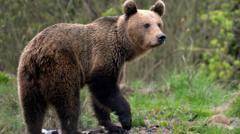Residents of a luxurious gated community near Buenos Aires are at odds over the burgeoning capybara population. As these large rodents thrive in their man-made habitats, wildlife experts are stepping in to control the numbers through sterilization efforts.
**Capybara Controversy: A Gated Community in Argentina Struggles with Overpopulation**

**Capybara Controversy: A Gated Community in Argentina Struggles with Overpopulation**
In Nordelta, Argentina, a wealthy neighborhood grapples with the increasing population of capybaras, with some residents arguing there's such a thing as too many.
Luciano Sampietro, a local veterinarian, employs sedative-laced blow darts to stabilize capybaras before performing sterilizations, addressing the balance between nature and community demands. Amidst their rising popularity as viral internet sensations loved for their endearing behavior, tensions persist over their growing numbers within residential areas.
In Nordelta, the picturesque setting is now marred by this capybara dilemma, raising questions of how urban expansion impacts local ecosystems. While some community members appreciate these adorable creatures, others feel their presence is overwhelming.
As capybaras continue to thrive in these niches, Nordelta finds itself at the crossroads of wildlife conservation and residential life.
While the appeal of capybaras remains strong, the issue reflects broader debates about wildlife management in human-dominated spaces, illustrating the challenges faced when nature intermingles with suburban living.
In the end, the struggle in Nordelta is emblematic of a larger conflict: how do communities find harmony with our wild counterparts, especially when they become too numerous?
In Nordelta, the picturesque setting is now marred by this capybara dilemma, raising questions of how urban expansion impacts local ecosystems. While some community members appreciate these adorable creatures, others feel their presence is overwhelming.
As capybaras continue to thrive in these niches, Nordelta finds itself at the crossroads of wildlife conservation and residential life.
While the appeal of capybaras remains strong, the issue reflects broader debates about wildlife management in human-dominated spaces, illustrating the challenges faced when nature intermingles with suburban living.
In the end, the struggle in Nordelta is emblematic of a larger conflict: how do communities find harmony with our wild counterparts, especially when they become too numerous?


















